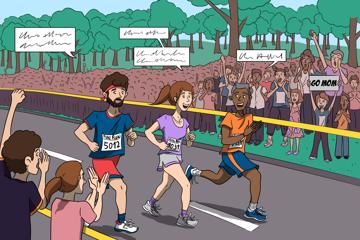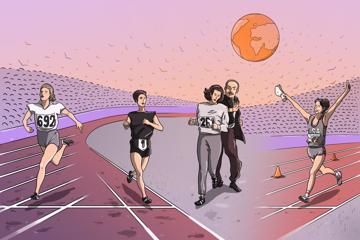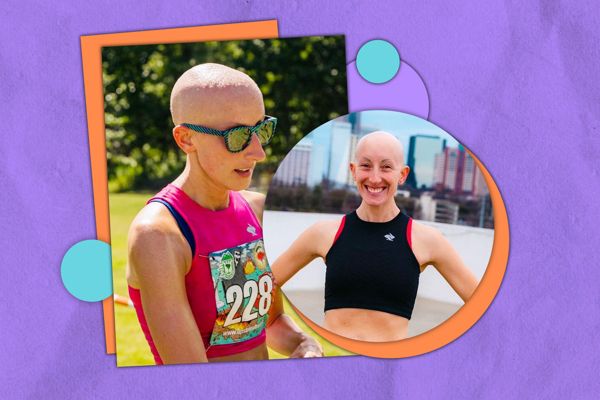Boost to the brain (© Christel Saneh)
 You've probably heard about the 'runner's high', but there is actually some science to back up the theory that exercise can help your brain as well as your body.
You've probably heard about the 'runner's high', but there is actually some science to back up the theory that exercise can help your brain as well as your body.
Kate Carter (@katehelencarter)
Regular runners know there's something near-magical about a run on a bad day. It doesn't matter how irked you are with the mundane stresses of life, how tired you are, how bored you are – life after a run always seems that little bit better.
Even after the most sleep-deprived night, there's a certain clarity that comes after a nice, easy paced run that makes your mind feel better, even if your body still longs for bed. I've never appreciated this more than I do now, in these uncertain, disquieting times.
But for years I just accepted this as fact – and never thought to wonder why. Then, a while ago, I started looking into what actually happens in your brain when you run. And my mind was, suitably, blown.
That our muscles and our hearts and our lungs work harder when we run is obvious. But inside your grey matter, too, things change. Much of what we know about this is very new and is still limited – and for obvious reasons. How do you study brain chemistry changes without cutting open the head? You also can't run in an MRI machine – or not yet, anyway. Nevertheless, in 1999, scientists made a staggering discovery. They divided their runner subjects – mice, not humans – into two groups: one given free access to a gym (ok, a wheel) and one group who got nothing. And guess what? The ones who ran actually had bigger brains.
Running causes a whole complex chain of interlaced reactions, in humans as in mice – increased blood flow to the brain, growth in the network of blood vessels, changes in some hormone levels. And, astonishingly, the birth of new neurons – something that, until a few decades ago, was actually thought not to occur once we reach adulthood. Now we know that actually, it continues through life, and is actively stimulated by exercise.
And exercise doesn’t just create new brain cells; it makes them work better. Studies have shown that it stimulates the levels of a protein known as BDNF – brain-derived neurotrophic factor. This protein helps both the birth and survival of fragile new-born neurons. Children who exercise even have bigger hippocampal regions of the brain – the area essential for memory formation and spatial navigation (and the area that is particularly associated with age-related decline).
Aerobic exercise also improves your attention span, multitasking ability and decision-making process – and it’s never too late to start. A 2015 study saw increases in hippocampal volume in adults after only six weeks of regular exercise for previously sedentary people. Even in adults with degenerative diseases such as Alzheimer’s, studies show that exercise can have a beneficial effect on cognition.
As for that miraculous post-exercise glow, there’s science to explain that too. Running has a steep learning curve and the first few weeks are tough, but if you get over that, you will hopefully have a run where you suddenly ‘come to’ and realise minutes – maybe even miles – have passed without you noticing. This phenomenon is called the ‘transient hypofrontality hypothesis’ – the brain prioritising the areas it need for the physical act of running over those associated with analytical thinking – or indeed overthinking.
So you zone out into that flow state where you are just moving, being in the moment, life’s cares temporarily vanished.

Conversely, sit around with nothing to do – or lie awake at night – and you’ll soon find yourself in that state where unproductive thoughts chase each other endlessly and fruitlessly round your brain. In your brain, this state is associated with having an overactive ‘default mode network’ (a series of linked areas of the brain). When we run, activity in these areas diminishes. And again, we feel better.
And I haven’t even touched yet upon endorphins – those ‘happy hormones’ that exercise produces. Until recently there was mystery here too – how did these hormones affect the brain when they were thought not to be able to cross the ‘blood/brain barrier’? Recent experiments have revealed that they do, though how they do it is still unknown.
Then there’s the endocannabinoids – neurotransmitters which bind to the cannabinoid receptors in the brain and create a similar effect as those of the active component in cannabis: pain relief, reduction of stress, relaxation. All, of course, perfectly legal.
Both endorphins and endocannabinoids are thought to be involved in the fabled ‘runners high’, that glow that for some people is intense, in others more of a mild buzz. Even regular runners don’t necessarily feel it often, but it’s worth it for the moments when we do.
For me, understanding what is happening in the brain – insofar as I can understand the complex science, which is probably ‘not much’ – only adds to the mystery and the sense of wonder that something so simple (one foot in front of the other, move a bit quicker) can produce something so valuable. And more valuable now, surely, than ever.










